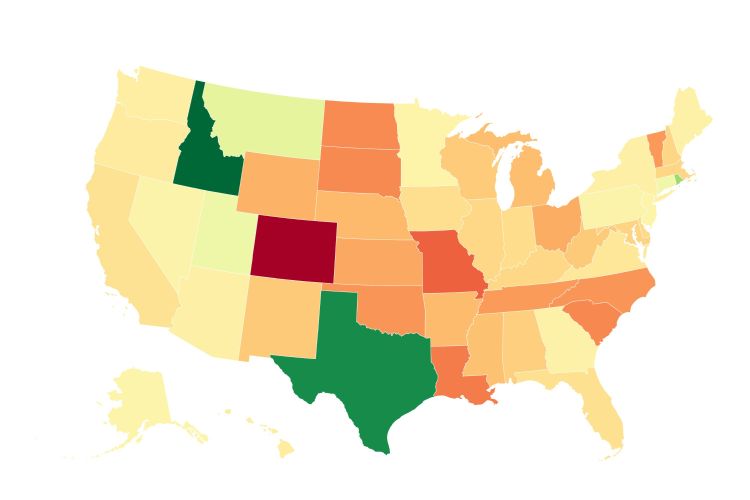Map shows states where mortgage rates are increasing the most

A new map shows which U.S. states have seen the sharpest increase in mortgage rates this year, driven by a combination of economic factors, including inflation and fluctuating real-estate demand.
Colorado was the state with the largest average mortgage interest rate increase between the first and second quarters of 2024, at around 4.9 percent, according to a study by WalletHub. The report notes that this was significantly higher than increases in other states. Only Missouri (the second highest average increase) saw a rise of above three percent over this period.
Colorado's average rate rose to 5.7 percent in Q2 2024, which only made it the 29th-most expensive state, the study said. New Jersey was the state with the highest average rate overall, with 7.37 percent.
Coming in second was Missouri. The state experienced an average rate rise of 3.1 percent, with an average rate of 6.3 percent – making Missouri the 11th-most expensive state for mortgage rates in the U.S.
WalletHub also noted that Missouri residents deal with relatively costly real estate taxes in addition to high mortgage rates.
In third was Louisiana. Residents of the Pelican State saw interest rates rise by 2.7 percent on average between Q1 and Q2 2024.
Now at 6.8 percent, this meant Louisiana had the seventh-highest average in the country. WalletHub said the average rates in the U.S. ranged from approximately 4.8 percent to 7.4 percent.
"Because of Louisiana's high interest rates, it's not surprising that it ranks ninth among the states where mortgage delinquency is increasing the most," read the report.
"This is further supported by the fact that it's among the top 10 states with the most people in financial distress."
To determine its findings, WalletHub analyzed its proprietary user data on mortgage interest rates from Q1 to Q2 2024.
WalletHub analyst Chip Lupo told Newsweek, "Mortgage rates are unlikely to go up further, given the Federal Reserve's apparent desire to cut its target rate. This should help prospective home buyers and the housing market generally."
Only a handful of states saw average rates fall over the period in question.
These were Idaho (-1.2 percent), Texas (-0.95 percent), Rhode Island (-0.45 percent), Montana (-0.14 percent), Utah (-0.09 percent), and Connecticut (-0.07 percent).
Although eight of the top 10 states in the report were Republican voting, more red states than blue saw a quarterly decrease. Lupo told Newsweek there were "examples from both sides of the aisle of states doing well and states doing poorly."
Newsweek previously spoke with Jason Obradovich, chief investment officer at mortgage lender New American Funding, about what an election year could mean for the housing market.
"There is certainly a human element to housing prices and mortgage rates. As a result, election years can bring more volatility to prices and rates than in non-elections years. However, those moments of volatility are fleeting," Obradovich said.
"Overall, the effects on the market are more slow-moving and less prone to swings of emotion. It's always best to look at the housing market through a long-term lens."
Obradovich added: "More than anything, what typically affects the housing market in election years is the market's reaction to the election results. If the market believes the party that wins the election will stimulate growth, then we could see positive effects on the overall economic outlook."
Whilst an election can impact the housing market, the reverse is also true.
According to a survey by the Center for Popular Democracy, 84 percent of voters said housing was a major issue. Both Vice President Kamala Harris and former President Donald Trump have been making their cases to voters as to why they have the best plan to address their concerns.
Do you have a story we should be covering? Do you have any questions about this article? Contact [email protected]

































































